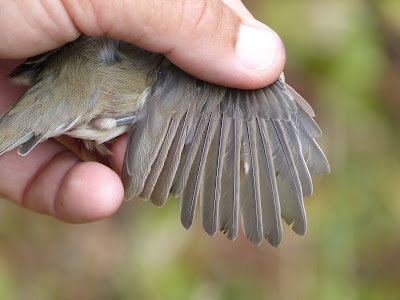The second heatwave of the summer has now passed, and we've also come through the thunder, lightning and torrential downpours that ensued once the hot spell broke. The farm tracks showed evidence that some water had been running through the farm, displacing gravel, but the fields looked in good shape with the low vegetation, whether stubble or cover crop preventing run off and loss of top soil. The ground around the area where we set nets was noticeably softer underfoot.
One of 12 Whitethroats processed today.
Lesser Whitethroat in post juvenile moult
One of two Willow Warblers. Both were hatched this year and have
completed their post-juvenile moult in preparation for their first migration south.
As in recent sessions, Whitethroat was the leading species. The catch was a good representation of the birds seen moving about the site, five species being summer migrants.
Adult male Blackcap AXD4199 was ringed, by another ringer/group, as a juvenile in September of last year and we await details. He is currently in the process of renewing his flight feathers. Note short outer primaries that are not yet fully grown and the old lighter, outer feather that has not yet dropped and has still to be replaced.
This young Robin would have hatched fairly late in the breeding season and has barely begun to develop its diagnostic red breast as it moults out juvenile feathers in its post juvenile moult.
Additional observations included a Green Woodpecker, 2 Marsh Harrier, Red Kite, 5 Common Buzzards and a juvenile European Stonechat.
A spectacular sunrise, a perk to follow the 5am alarm.
Total: 25 (2)
Wren - 1
Robin - 2
Lesser Whitethroat - 1
Whitethroat - 12
Blackcap - 2 (1 control)
Chiffchaff - 2
Willow Warbler - 2
Long-tailed Tit - 0 (1 control)
Blue Tit - 2
Goldfinch - 1















.JPG)












